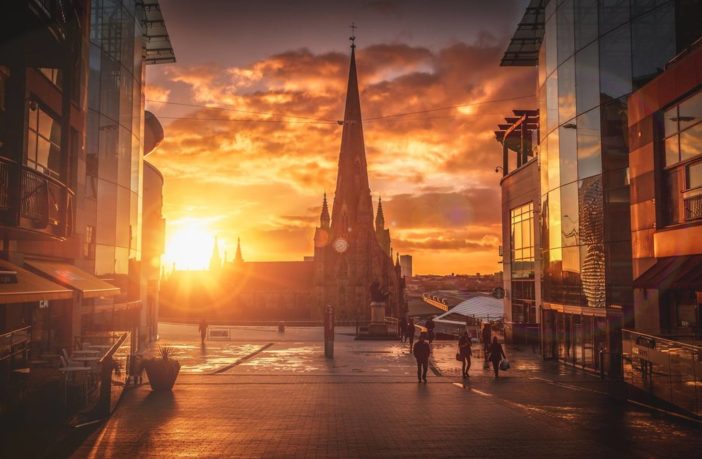There are many interesting cities in the UK, many of them are quite popular, and some are not very famous among tourists. This is the city of Birmingham – in this article, we will talk about the history and interesting facts from the life of this city.
Birmingham is the second largest city in the UK and the center of the West Midlands. Once the flagship of the Industrial Revolution, it is now a modern metropolis with a vibrant cultural scene. Birmingham is a city of important industrial heritage and rich history, nicknamed “the workshop of the world” and “the city of 1000 crafts” during the Victorian era. Its most notable feature is its extensive canal network, which is a testament to past industrial development. There are more canals in Birmingham than in Venice and Amsterdam. Unfortunately, the historical center of the city was significantly destroyed during the Second World War, and modern architecture greatly distorted the look of the city.
Geography and Climate
Birmingham is located in Central England on a rolling plateau between the valleys of the rivers Severn and Trent. The city has a temperate maritime climate with slightly cooler winters and warmer summers than the rest of the UK.
History
Birmingham as a settlement was founded in the 6th – 7th century. The modern name comes from the Old English Beormingahām, meaning “house” or “village”. The first mention of the city dates back to 1166. By the 13th century, Birmingham had become a major trading center and became famous for its fairs.
The heyday of Birmingham begins in the 16th century, when ironworks were built here. By the 18th century, the city became one of the largest industrial centers in England. Birmingham also attracts many famous scientists and engineers who lived and worked here during this period.
In the 20th century, the city became a major center for the military industry. This was the reason for the massive bombing of the city by German aircraft, which significantly damaged the historical center.
Attractions
The historic center of Birmingham was seriously destroyed during the Second World War. It is now a mixture of classic Victorian architecture and modern buildings. One of the most beautiful buildings in Birmingham is the City Hall, which is considered a masterpiece of 19th century architecture. This impressive building is reminiscent of an ancient Roman temple and features 40 ornate marble Corinthian columns.
The Jewelery Quarter is Birmingham’s pride and tradition, with 200 jewelery workshops. There is also a museum of jewelers.
Cathedral of St. Philippa is a cathedral built in the first half of the 18th century. The building was destroyed during the bombing of 1940 and rebuilt in 1948.
Birmingham’s canals are its real attraction. The oldest of them date back to the 18th century and were built during the industrial revolution. The total length of these waterways is several hundred kilometers, which exceeds the length of the canals of Venice. The city has many interesting sights, but if you don’t really like walking around the city, you can try online entertainment – for example, online casino promotions.
Museums in Birmingham
- The Birmingham Museum and Art Gallery is one of Britain’s finest cultural sites with magnificent archaeological finds and art from the 17th to 19th centuries.
- Birmingham Science Museum – An interesting collection of steam engines from locomotives to tractors and industrial equipment.
- The National Center for Marine Life is a huge ocean aquarium with a unique underwater tunnel and many other sea-related exhibits.
Origin of the Name
Birmingham, in addition to its large size, is one of the most ancient cities in the British Isles. According to one version, the name of the city comes from the name of an ancient tribe called Beyormings. Their leader was called Beyorma, who was considered the founder or patron of the clan. But scientists have not yet been able to establish exactly where the first Bayorming settlement was located. Although it was possible to prove that this territory was the border between two kingdoms, one of which belonged to the Angles, and the second to the Saxons (Hvikke tribes). The Angles created in the 7th century. AD the kingdom of Mercia was subjugated to the Hvikka, but then the attack of the Danes became a victim. So, already in the 9th century. this kingdom was incorporated into Wessex, in which many counties arose.
The entire territory of modern Birmingham was divided into three parts – Staffordshire, Worcestershire, Warwickshire. According to another version, the name of the city and the county appeared only after the Normans captured England. Then part of the land passed into the possession of the de Birmingham family, who took this surname from the name of one of the estates that existed there. Already in the 11th century. Birmingham was a fairly small rural community, with a small population. But representatives of the family gradually began to expand it, include neighboring territories, surround it with ditches and ramparts in order to protect themselves from enemies.
Stages of Historical Development: From Antiquity to the 19th Century
The settlement of the territory of the modern city-county began in primitive times, or rather, in the era of the Lower Paleolithic. This is evidenced by archaeological finds. Later, the territory of Birmingham became deserted, which was caused by the onset of a new ice age. And only in the Stone Age, about 10, 4 thousand years ago, human settlements appeared here again. Their inhabitants were engaged in traditional work for that time – they hunted, fished, gathered berries, leaves, roots. It is not known exactly where the Stone Age people lived, but it is assumed that these were caves. Only in the Neolithic, 4-3 thousand BC. started showing up at home.
Evidence of ancient times are numerous burial mounds, created in a rather curious way. They were built from burnt bricks. The main part of such structures was erected in 2 thousand BC. Next to these monuments are traces of later settlements dating back to the Bronze and Early Iron Ages. They were replaced by the Roman era, as evidenced by a fairly large number of artifacts found within the modern city. When the Roman garrison in the 2nd c. AD left Birmingham, the settlement began to gradually fade away. People almost did not settle here, because the land was unsuitable for agriculture. Neighboring lands, which are now suburbs, were better developed. The problem for settling deep into the plateau was the fact that a vast territory was occupied by a forest, called the Arden. One of the features of the de Birmingham family nest was the organization of markets that were held near the walls of the castle. It was this factor that gave impetus to the active and rapid development of the city in the second half of the 12th century.
This happened only after one of the representatives of the family – Peter de Birmingham – bought a privilege from Henry the Second. It was a document that allowed organizing fairs every week, collecting taxes from them, and also gave the right to the owner of the castle to start building the city. So in Birmingham a market square appeared and trade routes were expanded. In addition, new churches and city buildings began to appear. Thanks to the presence of the market, the city quickly became the center of the region, the population of which was constantly increasing, new lands were being developed, which caused an increase in taxes. Quickly enough, Birmingham became a famous city of artisans, various craftsmen, merchants and merchants.
The market mainly sold agricultural and agrarian products. In the 14-16 centuries. these industries were added by others – woolen, meat, dairy, weaving, tailoring, pottery, etc. A little later, metal processing workshops began to open. Their development was facilitated by the active mining of ore, coal, the proximity of rivers capable of moving blower furs. Knives, nails, weapons, sabers were popular among buyers in the markets of Birmingham. Artisans could not compete with the coupes from the seaports of the country, since the coast had to be reached very far. Already in the 18th century. Birmingham became a major industrial center with a population of nearly 15,000 people. The development of the city was also facilitated by the industrial revolution, which engulfed neighboring settlements, as well as the reorganization of local government. In particular, in 1760 a special Council appeared, dealing with the improvement of the city.
At the turn of the 18-19 centuries. Birmingham became famous for scientific discoveries and sectarian riots. At that time, James Watt, W. Murdoch, M. Boulton, J. Priestley presented their achievements to the public, who discovered gas lighting, steam engines, which made it possible to mechanize labor and divide it. In the city, at the same time, there was an open struggle between Quakers and Methodists, which resulted in pogroms, destruction, and murders of representatives of various religious communities. Despite the difficult social situation, the arms industry was actively developing in the city, which made it possible to transport products to the British colonies on the African continent, trade with the rest of Europe and the United States of America.


